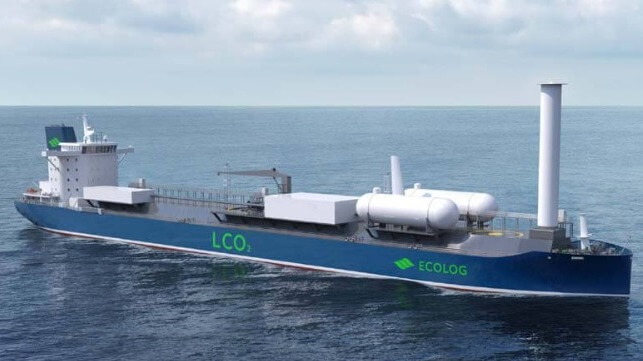LCO2 Carrier Design Developed by Deltamarin for ECOLOG’s CO2 Platform

Designs were presented for the first of a fleet of purpose-built CO2 carriers to transport captured CO2 intra-Europe for storage. The designs were developed by the well-known Deltamarin Group, part of China Merchants, for ECOLOG, an emerging services company that seeks to build the first large-scale CO2 services platform.
Based in Greece and established by Greek shipping tycoon Peter Livanos, ECOLOG is using the model of the gas sector to develop its business model. It plans to be a mid-stream company operating a service platform in the carbon capture, utilization, and sequestration supply chain. According to its statement, the company is building a business that would liquefy, transport, and store 50 million tons of CO2 annually anywhere in the world.
The vessel concept is for short-range transportation. ECOLOG plans to develop a fleet of vessels and terminals connecting hard-to-abate emitters, such as large industrial sites, and providing connections to sequestration sites or re-use facilities.
Deltamarin says in developing the vessel it worked to optimize the LCO2 aspects. It explains that there are different configurations of cargo containment and handling available to address the wide variety of CO2 compositions.
They did not provide details on the size of the vessel but said it is designed to be a versatile and efficient carrier. It uses a low-pressure cargo system and would have a shallow draft to facilitate access to facilities. To reduce the vessel’s environmental impact, they selected dual-fuel LNG engines along with wind-assisted propulsion and capabilities to use shore power.
The designs were developed for the purpose of tendering at shipyards worldwide. No timeline was proposed for construction and entry into service.
ECOLOG’s vessels would follow the Northern Lights vessels which are currently completing construction in China. Each of the ships will have a capacity of 7,500 cubic meters designed to transport captured CO2 from European producers to the Northern Lights’ terminal in Norway before pumping the CO2 to the offshore storage location. The company has agreements for a total of four ships with the first two expected to be delivered this year.
